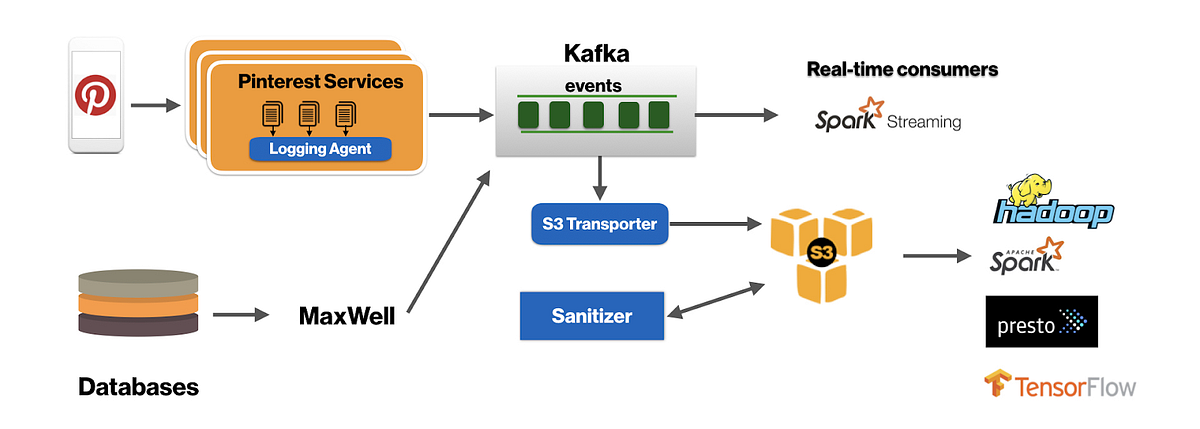Theory of Operation
Tablesnap is a script that uses inotify to monitor a directory for IN_MOVED_TO
events and reacts to them by spawning a new thread to upload that file to
Amazon S3, along with a JSON-formatted list of what other files were in the
directory at the time of the copy.
When running a Cassandra cluster, this behavior can be quite useful as it allows for automated point-in-time backups of SSTables. Theoretically, tablesnap should work for any application where files are written to some temporary location, then moved into their final location once the data is written to disk. Tablesnap also makes the assumption that files are immutable once written.
Installation
The simplest way to install tablesnap is from the Python Package Index, PyPI. https://pypi.python.org/pypi/tablesnap
pip install tablesnap
This distribution provides a debian/ source directory, allowing it to be built as a standard Debian/Ubuntu package and stored in a repository. The Debian package includes an init script that can run and daemonize tablesnap for you. Tablesnap does not daemonize itself. This is best left to tools like init, supervisord, daemontools, etc.
We do not currently maintain binary packages of tablesnap. To build the debian package from source, assuming you have a working pbuilder environment:
git checkout debian git-buildpackage --git-upstream-branch=master --git-debian-branch=debian --git-builder='pdebuild'
The daemonized version of the Debian/Ubuntu package uses syslog for logging.
The messages are sent to the DAEMON logging facility and tagged with
tablesnap. If you want to redirect the log output to a log file other than
/var/log/daemon.log you can filter by this tag. E.g. if you are using
syslog-ng you could add
# tablesnap
filter f_tablesnap { filter(f_daemon) and match("tablesnap" value("PROGRAM")); };
destination d_tablesnap { file("/var/log/tablesnap.log"); };
log { source(s_src); filter(f_tablesnap); destination(d_tablesnap); flags(final); };
to /etc/syslog-ng/syslog-ng.conf.
If you are not a Debian/Ubuntu user or do not wish to install the tablesnap package, you may copy the tablesnap script anywhere you'd like and run it from there. Tablesnap depends on the pyinotify and boto Python packages. These are available via "pip install pyinotify; pip install boto;", or as packages from most common Linux distributions.
Configuration
All configuration for tablesnap happens on the command line. If you are using
the Debian package, you'll set these options in the DAEMON_OPTS variable in
/etc/default/tablesnap.
usage: tablesnap [-h] -k AWS_KEY -s AWS_SECRET [-r] [-a] [-B] [-p PREFIX]
[--without-index] [--keyname-separator KEYNAME_SEPARATOR]
[-t THREADS] [-n NAME] [-e EXCLUDE | -i INCLUDE]
[--listen-events {IN_MOVED_TO,IN_CLOSE_WRITE}]
[--max-upload-size MAX_UPLOAD_SIZE]
[--multipart-chunk-size MULTIPART_CHUNK_SIZE]
bucket paths [paths ...]
Tablesnap is a script that uses inotify to monitor a directory for events and
reacts to them by spawning a new thread to upload that file to Amazon S3,
along with a JSON-formatted list of what other files were in the directory at
the time of the copy.
positional arguments:
bucket S3 bucket
paths Paths to be watched
optional arguments:
-h, --help show this help message and exit
-k AWS_KEY, --aws-key AWS_KEY
-s AWS_SECRET, --aws-secret AWS_SECRET
-r, --recursive Recursively watch the given path(s)s for new SSTables
-a, --auto-add Automatically start watching new subdirectories within
path(s)
-B, --backup Backup existing files to S3 if they are not already
there
-p PREFIX, --prefix PREFIX
Set a string prefix for uploaded files in S3
--without-index Do not store a JSON representation of the current
directory listing in S3 when uploading a file to S3.
--keyname-separator KEYNAME_SEPARATOR
Separator for the keyname between name and path.
-t THREADS, --threads THREADS
Number of writer threads
-n NAME, --name NAME Use this name instead of the FQDN to identify the
files from this host
-e EXCLUDE, --exclude EXCLUDE
Exclude files matching this regular expression from
upload.WARNING: If neither exclude nor include are
defined, then all files matching "-tmp" are excluded.
-i INCLUDE, --include INCLUDE
Include only files matching this regular expression
into upload.WARNING: If neither exclude nor include
are defined, then all files matching "-tmp" are
excluded.
--listen-events {IN_MOVED_TO,IN_CLOSE_WRITE,IN_CREATE}
Which events to listen on, can be specified multiple
times. Values: IN_MOVED_TO, IN_CLOSE_WRITE, IN_CREATE
(default: IN_MOVED_TO, IN_CLOSE_WRITE)
--max-upload-size MAX_UPLOAD_SIZE
Max size for files to be uploaded before doing
multipart (default 5120M)
--multipart-chunk-size MULTIPART_CHUNK_SIZE
Chunk size for multipart uploads (default: 256M or 10%
of free memory if default is not available)
For example:
$ tablesnap -k AAAAAAAAAAAAAAAA -s BBBBBBBBBBBBBBBB me.synack.sstables /var/lib/cassandra/data/GiantKeyspace
This would cause tablesnap to use the given Amazon Web Services credentials to
backup the SSTables for my GiantKeyspace to the S3 bucket named
me.synack.sstables.
Questions, Comments, and Help
The fine folks in #cassandra-ops on irc.freenode.net are an excellent
resource for getting tablesnap up and running, and also for solving more
general Cassandra issues.



